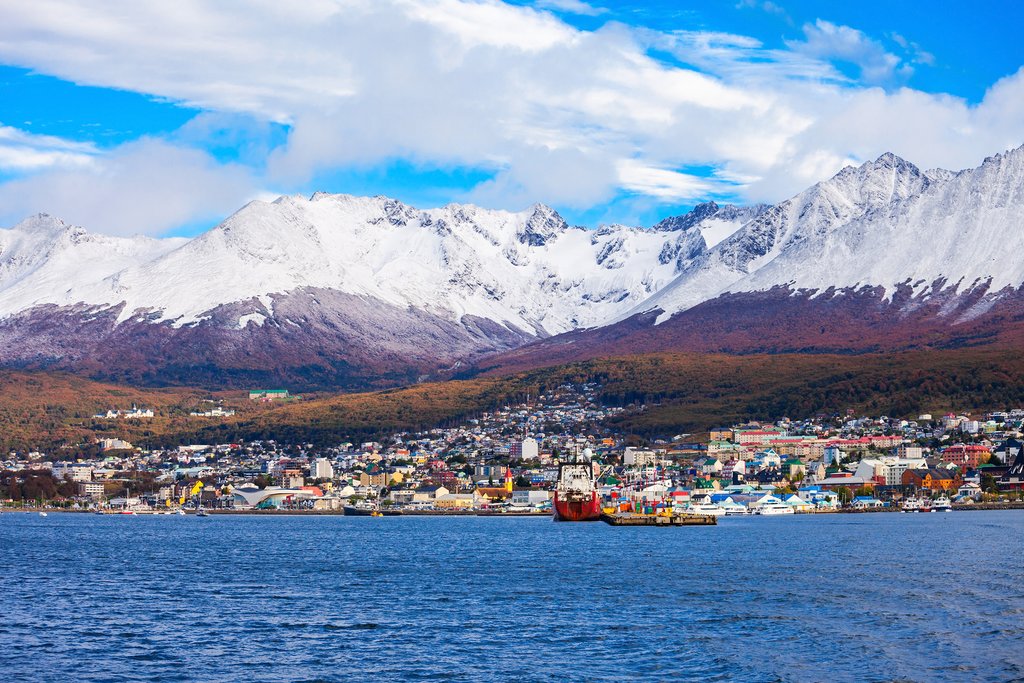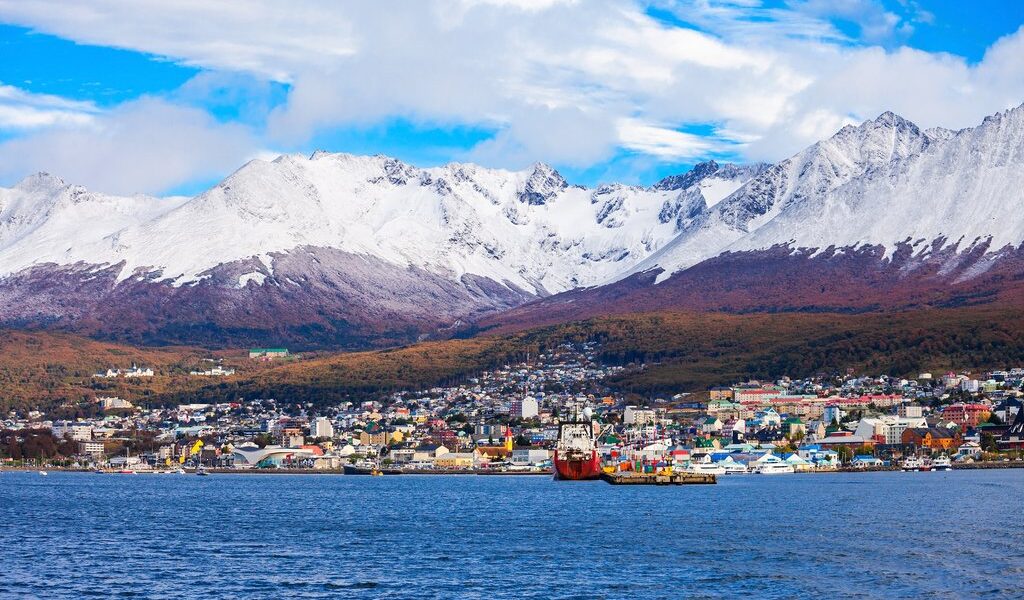
The southernmost city on earth, Ushuaia is just 600 miles north of Antarctica—Buenos Aires, by comparison, is more than twice as far away. Facing the Beagle Channel and backed by jagged mountain peaks, this remote but welcoming city is the gateway to the dramatic Andean landscapes of Tierra del Fuego. Our guide will help you plan your trip and find the best that Ushuaia has to offer.
Exploring Ushuaia: The Gateway to the End of the World
Ushuaia, the capital of Argentina’s Tierra del Fuego province, sits on the southernmost edge of South America. Nestled in the archipelago shared with Chile and located beyond the southern boundary of Patagonia, this fascinating city is often dubbed “El Fin del Mundo,” or “The End of the World.” With a population nearing 70,000 residents, Ushuaia is more than just a remote destination—it’s a dynamic urban center with a thriving tourism economy and a bustling port, not to mention a significant role in Argentina’s manufacturing sector. Despite these modern developments, Ushuaia has managed to preserve its rugged charm and frontier ambiance, making it a truly unique place to visit.
Planning a Trip to Ushuaia
Due to its remote location, planning ahead is crucial when visiting Ushuaia. Visitors are drawn here for its proximity to pristine natural landscapes, access to Antarctic cruises, and the opportunity to explore Tierra del Fuego National Park. The town is surrounded by dramatic scenery, including the snow-capped Martial Mountains to the north and the icy waters of the Beagle Channel to the south. These natural boundaries give the city a distinct and breathtaking backdrop that enhances its appeal.
The city offers a wide range of services and accommodations, from luxury hotels to budget hostels. Additionally, Ushuaia is well-equipped with banks, supermarkets, restaurants, and tour operators that cater to international visitors. Still, due to its seasonal tourism patterns, it’s wise to book early if traveling during peak times such as the southern summer months of December to February, when days are longer and temperatures milder.
What to See and Do in Ushuaia
Ushuaia is teeming with attractions that cater to adventurers, wildlife lovers, and culture seekers alike. One of the top destinations is Tierra del Fuego National Park, which lies just 7.5 miles (12 km) west of the city. This expansive park offers hiking trails through lenga forests, peat bogs, glacial rivers, and coastal viewpoints that provide incredible vistas over the Beagle Channel. The park is also a great place to spot native birds and wildlife, such as foxes and guanacos.
Another popular activity is riding the historic End of the World Train, a heritage railway that once transported prisoners from Ushuaia’s old penitentiary to logging camps in the early 20th century. Today, it offers a scenic journey through picturesque valleys and forests, ending at the entrance of the national park.
The Beagle Channel is a defining feature of the area. Cruises along the channel offer passengers the chance to spot sea lions, penguins, cormorants, and, occasionally, whales. These tours often include stops at Les Eclaireurs Lighthouse and the iconic Isla de los Pájaros. For those who prefer more hands-on experiences, kayaking the channel provides a peaceful and immersive perspective of the region’s beauty.
Ushuaia’s Unique History and Culture
Ushuaia is rich in history, having evolved from a remote missionary outpost to a penal colony and, eventually, to a vibrant city. The Museo Marítimo y del Presidio (Maritime and Prison Museum), housed in the old penitentiary, provides a deep dive into this transformation. Exhibits recount the city’s past through maritime artifacts, prison relics, and model ships that depict early expeditions through the southern oceans.
The city also serves as a cultural hub. Several art galleries and small museums celebrate the heritage of the indigenous Yaghan people, early European settlers, and Antarctic explorers. Seasonal festivals and markets add a festive flair, particularly during the summer months when the city sees an influx of tourists and cruise-goers preparing for Antarctic expeditions.
Outdoor Activities and Adventure
Ushuaia is often considered the adventure capital of southern Argentina. Beyond national park hikes and boat cruises, other popular outdoor pursuits include trekking to the Martial Glacier, which offers panoramic views over the city and channel. In winter, Ushuaia transforms into a snowy playground with skiing, snowboarding, and dog sledding available at Cerro Castor—the southernmost ski resort in the world.
More active travelers can also try scuba diving in the icy waters, mountain biking through forest trails, or camping under the stars. With such a wide range of nature-based experiences available, Ushuaia truly lives up to its status as a year-round adventure destination.
Where to Stay and Eat
Accommodations in Ushuaia are plentiful and cater to a range of travel budgets. From charming boutique hotels with mountain views to cozy hostels near the city center, there’s something for every traveler. Upscale hotels often provide spa facilities, gourmet dining, and even package tours to Antarctica or Tierra del Fuego National Park.
The city’s dining scene is equally diverse. Ushuaia is particularly known for its Patagonian cuisine, with dishes featuring locally sourced seafood, lamb, and king crab. Visitors shouldn’t miss the opportunity to try centolla (king crab), which is served fresh from the channel in many restaurants. Traditional Argentine fare, such as empanadas and grilled meats, is also widely available. Wine lovers will find Argentine Malbecs on most menus, and there’s a growing number of craft breweries offering local beers infused with Patagonian flavors.
How to Get There
Despite its remote location, Ushuaia is surprisingly accessible. The city is served by Malvinas Argentinas International Airport, which receives direct flights from Buenos Aires, El Calafate, and other major Argentine cities. The airport is located just a few kilometers outside the city and is well-connected by taxis and shuttle services.
Ushuaia can also be reached by land, though the journey is long and involves crossing into Chile and back into Argentina. Buses run from cities like Río Gallegos and Punta Arenas, and travelers should be prepared for multiple border checks and ferry crossings. Though more time-consuming, the overland route offers scenic landscapes and a deeper look at Patagonia’s vast wilderness.
Final Thoughts
Ushuaia is not just the world’s southernmost city—it is a place of breathtaking natural beauty, historical depth, and thrilling adventure. Whether you come for the chance to hike through the untouched wilderness of Tierra del Fuego, observe marine life in the Beagle Channel, or set off on a journey to Antarctica, Ushuaia delivers an unforgettable travel experience. Its blend of raw nature, compelling history, and unique geographic location make it an essential stop on any Argentine itinerary.
B-66

